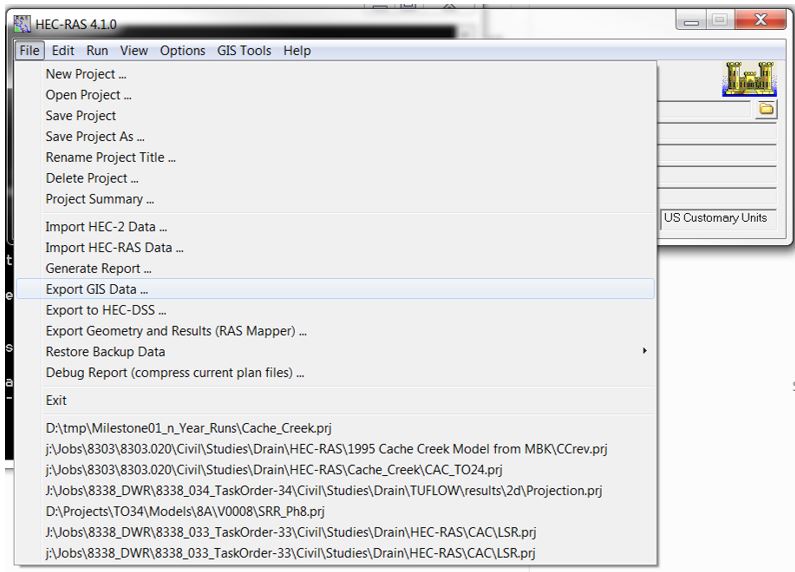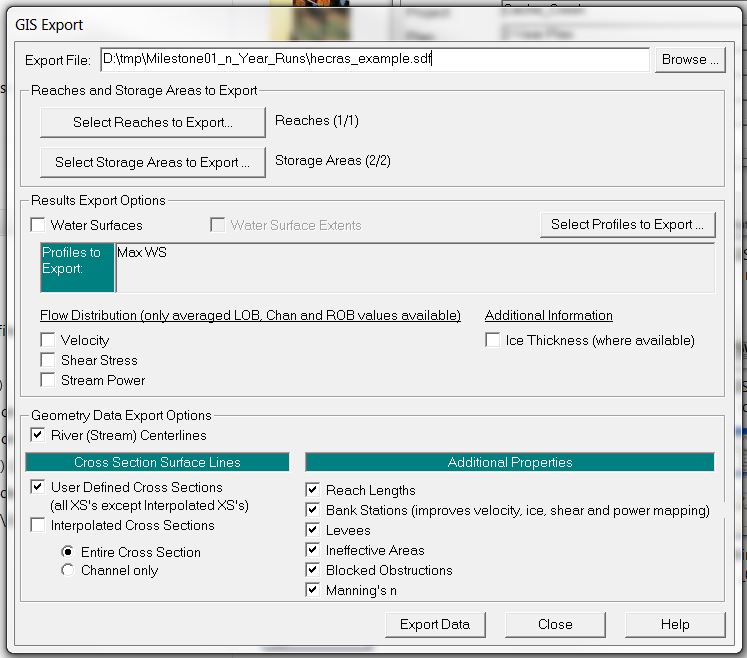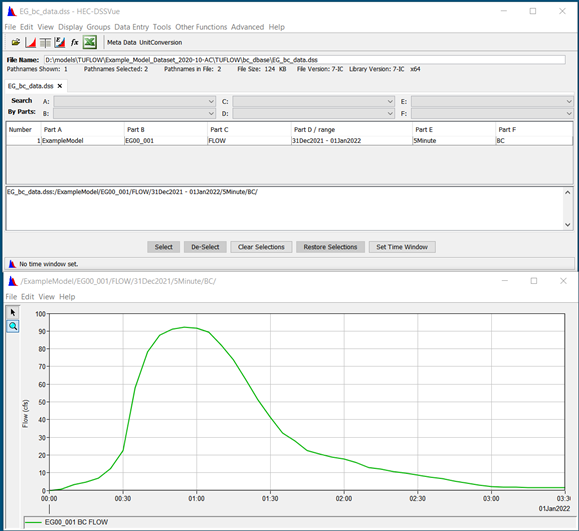HEC-RAS to TUFLOW: Difference between revisions
Chris Huxley (talk | contribs) |
No edit summary |
||
| Line 24: | Line 24: | ||
<li> Double click the batch file in windows explorer to execute the model conversion |
<li> Double click the batch file in windows explorer to execute the model conversion |
||
</ol> |
</ol> |
||
== Input Data Processing == |
== Input Data Processing == |
||
| Line 48: | Line 46: | ||
[[File:HECRAS_SDF_Selection.JPG|600px]] |
[[File:HECRAS_SDF_Selection.JPG|600px]] |
||
| ⚫ | |||
== Utility Execution == |
== Utility Execution == |
||
| Line 76: | Line 75: | ||
|- |
|- |
||
|"-notrim|| This command will prevent the utility from trimming cross-section data at levee markers. This is a non-default option due to most users converting HEC-RAS creek cross-section data into a TUFLOW 1D compatible format, whilst the surrounding floodplain in 2D areas are modeled in 2D (not requiring HEC-RAS inputs) |
|"-notrim|| This command will prevent the utility from trimming cross-section data at levee markers. This is a non-default option due to most users converting HEC-RAS creek cross-section data into a TUFLOW 1D compatible format, whilst the surrounding floodplain in 2D areas are modeled in 2D (not requiring HEC-RAS inputs) |
||
|} |
|} |
||
=== Example Syntax === |
=== Example Syntax === |
||
| Line 93: | Line 92: | ||
<u>Note</u> The above listed syntax assumes that the sdf_to_gis.exe, hecras_example.sdf file and associated batch file are located within the same directory. If not the case, absolute file path referencing will be required. For example: |
<u>Note</u> The above listed syntax assumes that the sdf_to_gis.exe, hecras_example.sdf file and associated batch file are located within the same directory. If not the case, absolute file path referencing will be required. For example: |
||
<li><tt>C:\TUFLOW\Utilities\HECRAS\sdf_to_gis.exe -mif -notrim hecras_example.sdf</tt></li> |
<li><tt>C:\TUFLOW\Utilities\HECRAS\sdf_to_gis.exe -mif -notrim hecras_example.sdf</tt></li> |
||
| ⚫ | |||
== Utility Output == |
== Utility Output == |
||
| Line 123: | Line 121: | ||
<li> ''<sdf_filename>_surf_line'': <br> |
<li> ''<sdf_filename>_surf_line'': <br> |
||
Point dataset reporting the location of each elevation values within the csv cross-section dataset. |
Point dataset reporting the location of each elevation values within the csv cross-section dataset. |
||
</ol> |
</ol><br> |
||
= Geometry Conversion (miTools) = |
= Geometry Conversion (miTools) = |
||
| Line 135: | Line 133: | ||
Refer to the <u>[[miTools_Tips | miTools Tips and Tricks]]</u> section for more information about miTools. |
Refer to the <u>[[miTools_Tips | miTools Tips and Tricks]]</u> section for more information about miTools. |
||
<br><br> |
|||
= Boundary Conditions (HEC-DSS) = |
= Boundary Conditions (HEC-DSS) = |
||
Revision as of 10:59, 24 January 2023
Introduction
This page outlines some utilities that may be used to convert HEC-RAS model files into a format which is compatible with TUFLOW.
If you have any suggestions to be included in these pages, please email support@tuflow.com.
Geometry Conversion (sdf_to_gis.exe)
The sdf_to_gis.exe utility is available for download from the TUFLOW website, it converts HEC-RAS geometric data into a TUFLOW compatible GIS (mif and shp) and csv input format. The utility outputs include:
- Centerline location data in GIS format
- Cross-section locations in GIS format
- Cross-section data in csv format
Note: This utility is currently still in its beta testing phase. Output should be carefully quality checked.
The steps required to use this utility are:
- Export the HEC-RAS geometry data into sdf format
- Create a GIS projection file for the conversion
- Create a batch file to run the utility
- Double click the batch file in windows explorer to execute the model conversion
Input Data Processing
The HEC-RAS model inputs need to be in SDF format (HEC-RAS export format), and must be geo-referenced using a real world projection.
Export the HEC-RAS sdf file using: File >> Export GIS Data...
Select the following items within the GIS Export window:
- River (Stream) Centerlines
- User Defined Cross Sections
- Entire Cross Section
- Reach Lengths
- Bank Stations
- Levees
- Ineffective Areas
- Blocked Obstructions
- Manning's n
Utility Execution
The utility requires GIS projection information to correctly translate the spatial dataset from SDF format to *mif or *.shp format. This is done by including either a projection or header file in the same folder directory as the SDF file. The utility will use the projection information from this file for the data conversion.
- mif format input requirement: Projection.mif or Header.mif
- shp format input requirement: Projection.prj or Header.prj
The following error message will be produced if projection information is not available:
ERROR - A Header.prj or Projection.prj file does not exist in folder
The utility is currently limited to being run using a batch file. To create a batch file:
- Create a new text file in the same location as the sdf file. The name is arbitrary but the file must have the extension ".bat". For example, "run_sdf_to_GIS.bat".
- Enter the relevant command syntax to the batch file (refer to the 'Input Flags' table and examples provided below).
- Double click the batch file in windows explore to execute the model conversion.
Input Flags
A list of the input switches is provided below:
| Switch | Description |
|---|---|
| "-mif" | The output format will be the MapInfo Interchange format (.mif/.mid) recognised by most GIS software |
| "-shp" | The output format will be the ArcGIS Shapefile format. This can be opened directly in ArcMap OR QGIS (and most GIS software) |
| "-notrim | This command will prevent the utility from trimming cross-section data at levee markers. This is a non-default option due to most users converting HEC-RAS creek cross-section data into a TUFLOW 1D compatible format, whilst the surrounding floodplain in 2D areas are modeled in 2D (not requiring HEC-RAS inputs) |
Example Syntax
Description: Convert HEC-RAS sdf data to mif format, trimming cross-section at levee markers (default trim option):
Description: Convert HEC-RAS sdf data to shp format, trimming cross-section at levee markers (default trim option):
Description: Convert HEC-RAS sdf data to mif format, not trimming cross-section at levee markers:
Description: Convert HEC-RAS sdf data to shp format, not trimming cross-section at levee markers:
Note The above listed syntax assumes that the sdf_to_gis.exe, hecras_example.sdf file and associated batch file are located within the same directory. If not the case, absolute file path referencing will be required. For example:
Utility Output
sdf_to_gis.exe will output five GIS files and a series of csv files, one for each cross-section.
TUFLOW Input
- 1d_xs_<sdf_filename>_surf_line:
This dataset defines the location of the cross-sections. The file uses a format that is compatible with TUFLOW. The field attributes for "Source", "Type" and "Flags" have been pre-filled. - Cross-section csv files:
This dataset defines the cross-section properties. Across channel distance, channel elevation and manning's roughness have been pre-filled with the csv datasets.
Check Files
- <sdf_filename>_streams:
This file defines the centerline of the channel. This centerline data can be split using the cross-section data to define the 1D channel (1d_nwk) in a TUFLOW model. The following field attributes should be used if this check file is converted into a TUFLOW input:- "Len_or_ANA"= 0 (the length of the line/polyline is used).
- "n_or_n_F" = 1 (materials are being defined in the cross-section csv files. n_or_n_F is a multiplication factor of the cross-section manning’s n value).
- "US_Invert"= -99999 (the bed of the channel cross-section is used).
- "DS_Invert"= -99999 (the bed of the channel cross-section is used).
- <sdf_filename>_cut_line:
Echo of the cross-section line (non-trimmed). - <sdf_filename>_levee_pts:
Points defining the intersection of the cross-section line with the levee used to trim the cross-section dataset. - <sdf_filename>_surf_line:
Point dataset reporting the location of each elevation values within the csv cross-section dataset.
Geometry Conversion (miTools)
MiTools is a MapInfo add-on that is available for download from the TUFLOW website.
MiTools can be used to convert HEC-RAS geometry cross-section data into mif/mid spatial and csv tabular format for direct input into TUFLOW.
The tool provides various user options, such as:
- Inclusion of manning n within the cross-section csv dataset.
- Various overbank trim options (no trimming, deactivate or trim).
Refer to the miTools Tips and Tricks section for more information about miTools.
Boundary Conditions (HEC-DSS)
The 2022 TUFLOW Release introduced support for time-series data from HEC-DSS files within a TUFLOW boundary condition database.
HEC-DSS is a database system for time series, curve, gridded data and more developed by the U.S. Army Corps of Engineers Hydrologic Engineering Center (HEC). See their website at https://www.hec.usace.army.mil/software/hec-dss/ for more information. The format is used for HEC developed software for data input and output. Rather than convert HEC-DSS time-series curves for use in TUFLOW, DSS data used by a HEC-RAS model can now also be used directly in TUFLOW.
HEC-DSS files organise data into paths with six parts (Part A – Part F) that resemble how files are organised on disk. The image below shows an example DSS file with a single path, with the curve plotted below.
To use a HEC-DSS time-series curve within a TUFLOW model, save a copy of the HEC-DSS input file to the TUFLOW bc_dbase folder and enter the following information into the TUFLOW boundary condition database:
- Enter the TUFLOW boundary condition location ID in the "Name" column.
- Provide the HEC-DSS filename in the “Source” column.
- Leave “Column 1”, which is used for time, blank (DSS files store the time with the curve values).
- Identify the pathname in “Column 2”. Event placeholders such as __event__ can be used as part of the pathname. Wilcards (*) can be used for parts of the path, however, ensure the wildcards will not select more than one path within the file.
- The “Add” and “Mult” columns can be used to offset or scale the time-series values, the same as non-DSS time-series curves.
The image below shows how the time-series curve above could be included in a boundary condition database. A wildcard is used for “Column 2” of the pathname (date range). Note that the pathname must start with a forward slash (/).
Name, Source, Column 1, Column 2, Add Col 1, Mult Col 2, Add Col 2, Column 3, Column 4 FC01, EG.dss, , /Example/EG01/FLOW/*/5Minute/BC/, , , , ,
By default, TUFLOW uses the first point in the time-series curve as TUFLOW time-zero. This can be changed using the TCF command “HEC-DSS Start Date” to identify the date/time that should be used for time-zero. The date should be in the isodate format: yyyy-mm-dd hh:mm:ss, where the time portions are optional.
- HEC-DSS Start Date == 2022-01-01
Note: Non-time series data such as gridded data from a HEC-DSS file is not supported at this time. Contact support@tuflow.com to request other features that would be beneficial to your workflows.
| Up |
|---|


